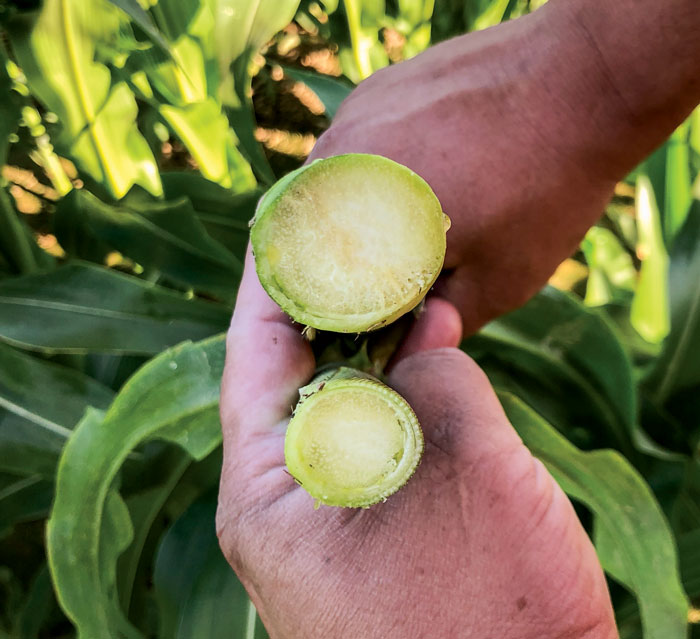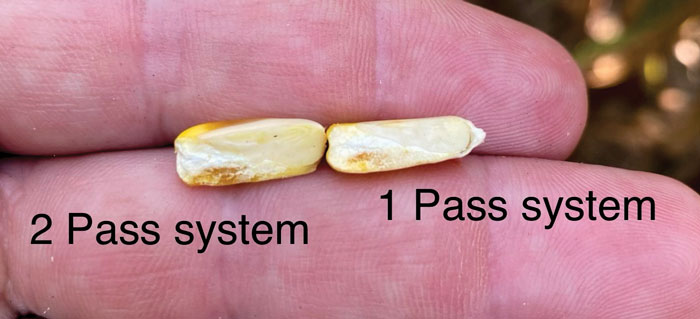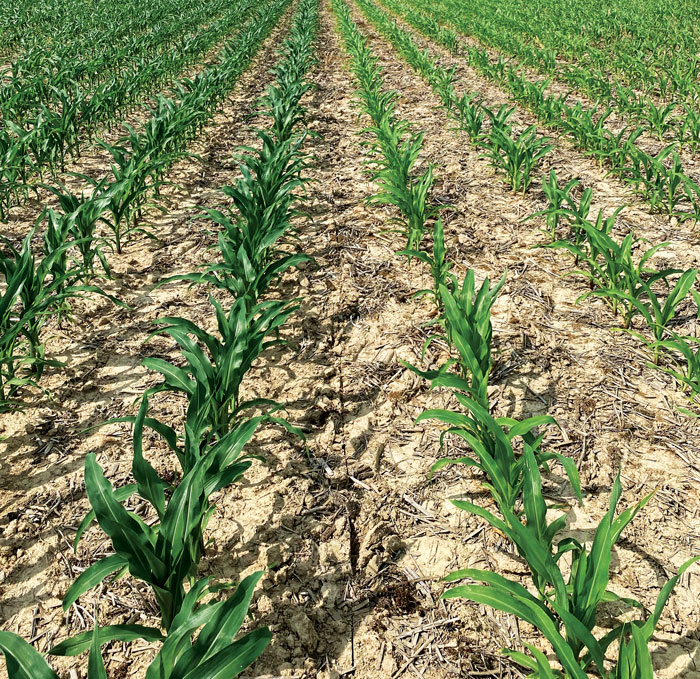Over the past 5 years, Chris Perkins has been challenging conventional wisdom in corn production with a systems-approach banding program that has bumped yields on his southwestern Indiana farm by an additional 50-60 bushels per acre.
The strip-tiller runs his family farmin Otwell, Ind., with the help of 7 full-time employees, whom he calls the backbone of the operation. He also owns Banded Ag, an ag research, consulting and custom application business involved in retail fertilizer sales and sales of Landluvr strip-till bars.
Perkins says his systematic approach to high-yield corn production was spawned by University of Illinois professor Fred Below’s work and publication, The Seven Wonders of the Corn Yield World.
“Dr. Below and I became friends more than 10 years ago when I cold-called his office to ask some questions concerning starter fertilizer,” Perkins says. “Since then, he’s become a close friend and my mentor in studying corn production in a systematic way. In my opinion, his Seven Wonders presentation may be one of the most important playbooks to ever hit agriculture.”
Strip-Till Takeaways
- Chris Perkins says the thought that 1 pound of nitrogen (N) is needed per bushel of corn yield is wrong. He’s had high corn yields with 0.57-0.63 pounds of applied N per acre. He says strip-tillers need to feed the plant, not the soil.
- Different hybrids have different responses to banded fertility. The ideal root structure is not too big but not too small because banding nutrients will efficiently feed a “just right” root system throughout the season.
- Some fungicides offer positive plant growth regulation benefits in addition to disease protection. Private seed trials show certain hybrids respond with significant yield increases when treated with fungicides even in the absence of severe disease pressure.
Four-Part Program
In 2013, inspiration struck Perkins while he was studying higher rates of starter fertilizer. The studies indicated significant growth differences without corresponding yields.
“The soil tests were saying we had plenty of nutrients, but we were still getting growth responses from adding more — up to 10 gallons of starter per acre,” Perkins says, “but it was not enough to take the plant through the season. It sped up growth, but I was convinced we needed a season-long ‘IV’ below the plant.”
Those observations and the phone call to Fred Below sparked his own intensive on-farm search for answers.
“Using the Seven Wonders precepts and many visits and phone conversations with Dr. Below, I started a journey which led to my current system to boost yields, improve profits and make better use of purchased inputs,” he says.
In 2017, Perkins built his first 8-row strip-till bar equipped with shanks and a 1,200-pound dry fertilizer box. He confined his work to 52 acres with experiments performed on 2 acres at a time.

SIZEABLE DIFFERENCE. These photos compare corn stalks under Perkins’ program (top) with corn taken from a nearby traditionally managed plot (bottom).
“I was convinced there was not enough emphasis on hybrid performance and nutrient placement along with nutrient uptake and fungicide use,” he says. “With all the variables I wanted to test in these trials, I realized it was going to take a long time to change corn-grower mentality.
“When Dr. Below first banded fertilizer on his corn plots in 2009, he saw significant yield and growth differences, but critics told him the process took too long to be practical. His response was, ‘If there’s enough money to be made or saved in the process, someone will figure it out.’”
Perkins figured out a 4-part program to do just that. His program includes careful hybrid selection, adequate and efficient application of nutrients for the crop, optimized planting populations, and a concerted effort to protect the health of the corn plants through the season.
He admits it’s a complex system, but it’s one that growers trust. Since 2017, the business has grown to more than 10,000 acres under contract for Banded Ag’s custom strip-till banded application in Indiana and Kentucky. Also, he says many growers in Indiana, Illinois, Missouri and Ohio are using the program on their own.
“Participation is growing every year,” Perkins says. “It’s very humbling and exciting at the same time.”
Perkins’ most recent overall corn yield average of 284.6 bushels per acre on his own farm was accomplished with 171 pounds of nitrogen (N) in the form of polymer-coated urea.
“We have several acres producing 330-350 bushels per acre and try to maintain 300 across the farm,” he says, noting the high yields have remained relatively constant throughout the past few years, while the lower-producing acres have shown the most yield increase.
“I shoot for 0.57-0.63 pounds of applied N per bushel of corn, so the old ‘1 pound of N per bushel of corn yield’ needs to go because it’s just wrong,” Perkins says. “We have to realize we’re feeding the plant, not the soil.”
Banded Boosts Bushels
Over the years, Perkins says he’s found a difference in the way hybrids respond to banded fertilizer. Those that perform the best may surprise many growers.
During a 20-inch corn trial, Perkins was army-crawling through the rows looking at the plants’ roots while his associates looked at the leaf and stalk structures. He noticed some plants had different overall root structures in the 20-inch row spacing, leading him to question if various hybrids would react differently to banded fertility if row spacing was making that much of a difference.
“We tested that theory the following year, and the results were overwhelming,” he says. “I’m looking for a smaller root structure with more fine and fibrous root hairs. I’m a big believer that large, course roots are a function of energy, so we want what I call Goldilocks roots, not too big, not too small, but just right. I’ve come to believe large roots can cost you yield.”

EXTRA PASS. The kernel on the left is the product of a 2-application fungicide program, while the kernel on the right had a single application. Perkins says many of his program acres will see a third application to extend plant vigor further into the growing season.
Perkins says banding nutrients where they will intersect root growth provides an efficient way to feed a smaller root system throughout the season, particularly as seeding rates go up and stands become more densely populated.
“When we first began testing hybrids on cooperators’ fields for the program, we planted 16 rows of our strip-till banded treatment, and right next to it we’d plant 16 rows of the grower’s program — which might have been dry application worked in, sidedress UAN, UAN worked in — it didn’t matter, we just compared the hybrid’s performance under the grower’s program vs. our program,” he explains. “The only thing that changed was the fertility and the concentration.”
Perkins placed his nutrients 7-8 inches deep in the strip-till berm through a single-tube outlet.
“We saw up to more than 50 bushel-per-acre yield increases with the banded fertilizer on some hybrids, and no difference on others,” he explains. “The results correlated almost to a T on our root observations, so I was convinced there is a difference in the way hybrids respond to banded fertilizer.”
Perkins says he screens hybrids each year and still conducts similar trials as those he started in 2017.
“I talk with seed dealers and select from their observations and literature,” Perkins says. “Usually the hybrids that do well for us are a little weak on health, are not the most drought resistant (smaller, fibrous root systems) and are noted for high yields.”
Feed the Plant, Not the Soil
Perkins says as he studied various corn hybrids for inclusion in his recommendations, he also studied plant nutrient uptake charts and consulted with other strip-tillers about their experiences.
“It became apparent they were still fertilizing as if they were broadcasting with no regard for chemical reactions in the root zone such as cation and anion relationships with plant nutrient availability,” Perkins says. “They were still feeding the soil and ignoring the plant because of variable rating and most times not even applying nitrogen.
“I was convinced all nutrients should be placed in one location to work as a single functioning unit, so we had to put the ‘IV’ directly below the plant to create one balanced food source available to the roots. I felt it was more important to put weight on root intersection than on diffusion or mass flow.”
“I’ve come to believe large roots can cost you yield…”
Over the years, Perkins has formulated a banding mix of N, phosphorus (P), potassium (K), sulfur, zinc and boron. He says it can be tweaked up or down, but typically it remains about the same as his original recipe.
“I’m also a huge believer in humics, fulvics and sugar,” he says, noting some growers depend solely on dry or solely on liquid fertilizer. “Why not take advantage of the best of both worlds?”
He’s added a liquid tank to their bar for “a fertilizer mix on steroids,” along with the dry box to keep costs in check. His Landluvr strip-till bars range from 6-row to 24-row widths for 30-inch row corn, and he can also make up to a 27-row, 45-foot bar for 20-inch rows.
“We place all of our nutrients for the year up front in the spring-built berms and watch it carry through the growing season with no sidedressing,” he says. “While I don’t always share my exact fertility program, I can tell you that each year we’re around 600 pounds per acre of applied nutrients representing our entire program.”
Increased Plant Populations
Perkins says his experience shows adopting strip-till banding frequently allows conventional or no-till growers to increase plant populations up to 4,000 plants per acre.
“Since every 1,000 plants correlates to 6-8 bushels per acre, we see corresponding yield increases with our program,” he says. “On my own farm, we typically average 38,600 seeds per acre. We don’t want high populations just for numbers’ sake, however. There has to be a positive return on investment for the additional seed expense.”

WEIGHTY MATTERS. These equations from the University of Illinois indicate the potential importance of increased plant populations and resulting individual kernel weight.
He says as plant populations increase, yield becomes a math equation: Plants per acre times kernels per plant times weight per kernel (See above chart).
“Depending upon a grower’s program, adding plants may increase kernel numbers but not affect the equation of total weight,” Perkins says. “It’s a balancing act on the math required to achieve higher yields. Banding nutrients allows us to feed more plants efficiently and maintain the constant of kernel weight for the yield equation.
“By striving to maintain kernels per plant, we now must maintain those extra kernels’ individual weights, which is a result of increased protein levels in each kernel. Protein has a direct correlation back to N, so we can figure our N uptake by figuring protein in the kernel. Higher protein kernels have a higher individual kernel weight.”
Perkins says the calculations of N uptake gives growers a focused picture of how much N they paid for and applied, compared to how much actually made it into the plant.
“I want to know I’m getting a good ROI on my N purchase,” Perkins says. “If the kernels can only account for 50% of what I bought, where is the other 50%? If you give $10,000 to a stockbroker, and at the end of the year your account balance only shows $5,000, you’d start asking questions. Why not do the same with your corn crop?”
Positive Fungicide Returns
Perkins says protecting the yield potential of a corn crop is vital to maximizing ROI, and that means taking steps to prevent plant diseases from robbing the combine at harvest.

DISTINCT ADVANTAGE. Chris Perkins’ Strip-till banded rows (left) show a distinct difference from the rows under a conventionally managed fertility program (right) during the early growing season.
“I can’t emphasize enough the positive returns in our program of fungicide use,” Perkins says. “Fungicides are sold to combat plant disease, and there’s no argument they accomplish that and are important for protecting yield. Some fungicides also offer positive plant growth regulation (PGR) benefits as well as disease protection.”
Fungicides are known to suppress ethylene production, a trait that can extend the productive phase of the corn plant by improving cell vigor and the conversion of photosynthetic products into protein and kernel fill.
Ethylene is a naturally produced gaseous plant hormone responsible for tassel and silk drop, yellowing leaves and leaf drop in corn at the end of the season.
“While ethylene production in corn plants is a natural reaction to shut down the plant at season’s end, ethylene released in the canopy of developing corn earlier in the season by stressed plants can inhibit valuable kernel fill and protein development in adjacent plants,” Perkins says.
Private seed trials across the Corn Belt show certain hybrids respond with significant yield increases when treated with fungicides even in the absence of severe disease pressure.
“Our program typically will see a minimum of two fungicide applications throughout the season, and well over the majority of our program acres will see a third,” he says. “But every application we make has to have an ROI.
“When we have even stands and plants in good condition, those plants are more in sync. When you begin to get ‘up and down’ plants, that shows they are stressed, and stressed plants give off ethylene and send it throughout the canopy to adjacent plants, which is a problem.
“We want to keep those plants green and thriving as long as we can throughout the season for the maximum development of kernels with the maximum of their potential kernel weight. The fungicides help us accomplish that.”







